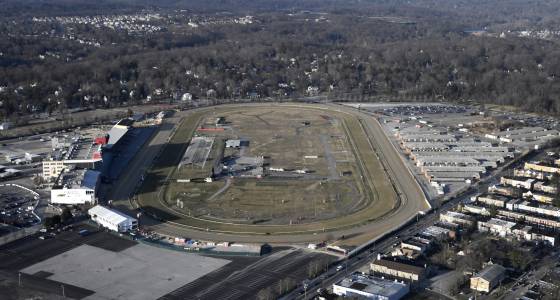The Maryland Stadium Authority study analyzing what would need to be done to make Pimlico suitable as the long-term host of the Preakness Stakes came with an eye-popping price tag: Somewhere in the neighborhood of $300 million worth of renovations — everything from utilities and restrooms to an overhaul of the grandstand, clubhouse and parking — would be necessary. At a time when neither the state nor the city is flush with cash and when the track's owner, the Stronach Group, has poured millions into refurbishing Laurel Park, that may seem like a stretch.
But the study nonetheless constitutes good news for those who value the tradition of the Preakness at Old Hilltop and for those who appreciate the economic value of holding the second leg of the Triple Crown in Baltimore. There is nothing inherently unsuitable about Pimlico's location and grounds, nor are the shortcomings of the aging facility insurmountable, the study found. Pimlico has a long way to go to come up to current safety and occupancy codes, not to mention to make it as attractive and vibrant as it could be, but the report lays out a plausible, baseline scenario for accomplishing those goals, and it may be possible to do even better than that.
Mayor Catherine Pugh has expressed her commitment to "do whatever is necessary" to keep Pimlico operational and the Preakness in place. Local and state leaders who represent the neighborhoods around the track fully support the effort to keep it viable. Gov. Larry Hogan hasn't publicly weighed in on the study, but he has previously supported keeping the Preakness in Baltimore. And perhaps most crucially, Stronach officials, while making clear that they aren't willing to foot the entire bill, have expressed a potential willingness to contribute.
That wasn't a sure thing, given that the Stronach Group has invested millions during the last few years to upgrade the grandstands, restaurants, seats, sightlines and more at Laurel. Given the overall decline of the racing industry, maintaining two modern tracks in close proximity to each other is a tough business case to make, and while the state would have to approve a move of the Preakness to Laurel (or anywhere else), it seemed plausible that the tracks' owners would eventually force the legislature's hand through benign neglect of Pimlico.
At least two big questions remain: how such a project would be financed and whether, even at $300 million, it is ambitious enough.
Some funding streams already exist that could become part of the basis for repaying bonds under a public-private partnership. Preakness and Laurel are already eligible for millions in annual capital improvement grants, and the Pimlico Community Development Authority also receives millions annually to spend on projects consistent with established neighborhood needs. Some use of those funds on Pimlico — particularly if the reconstruction included the use of local residents for labor — could make sense.
The Maryland Stadium Authority will release a long-awaited report on the future of Pimlico Race Course on Friday, with lawmakers and racing officials hoping the study will spur serious discussion about the site's long-term viability as home of the Preakness.
Though the report is only the first...
The Maryland Stadium Authority will release a long-awaited report on the future of Pimlico Race Course on Friday, with lawmakers and racing officials hoping the study will spur serious discussion about the site's long-term viability as home of the Preakness.
Though the report is only the first...
How much the Stronach Group might be willing to contribute is a major unknown, and it may well depend on the answer to questions about the scope of the improvements to the track. The current study only looked at the option of renovating the existing facility, but a complete tear-down and replacement could make more economic sense. Churchill Downs generates nine times the revenue from the Kentucky Derby than Pimlico does from the Preakness, partially because of the luxury boxes and other facilities that could not be accommodated in a mere renovation of Pimlico. Would additional investment beyond what is contemplated in this study be justified by its economic impact? (For that matter, would a complete rebuild actually be more expensive than renovation? It's not a given.)
Pimlico Race Course needs to be redeveloped at a cost between $250 million and $320 million to assure the 147-year-old north Baltimore facility remains a suitable home for the Preakness but questions loom about who might pay for it.
A widely anticipated study released Friday by the Maryland Stadium...
Pimlico Race Course needs to be redeveloped at a cost between $250 million and $320 million to assure the 147-year-old north Baltimore facility remains a suitable home for the Preakness but questions loom about who might pay for it.
A widely anticipated study released Friday by the Maryland Stadium...
Those are the sorts of questions that could be answered by a second phase of the study. The partners who paid for the first phase — the Maryland Stadium Authority, the Stronach Group and the Baltimore Development Corp. — need to come quickly to an agreement on the scope and funding plan for phase two so that we can begin to have a detailed debate about the costs and benefits of various scenarios.
It is true that Maryland has many competing needs that make investing heavily in a facility that's used only a few days a year seem questionable. But there's more at stake here than an emotional connection to the Preakness. The race has a massive economic impact on Baltimore that, with some investment, could be even greater. And the impact on the surrounding neighborhoods if Pimlico were allowed to die could be devastating. This study proves Pimlico and the Preakness can be saved. Now we need to figure out how best to do it.
Our editors found this article on this site using Google and regenerated it for our readers.












